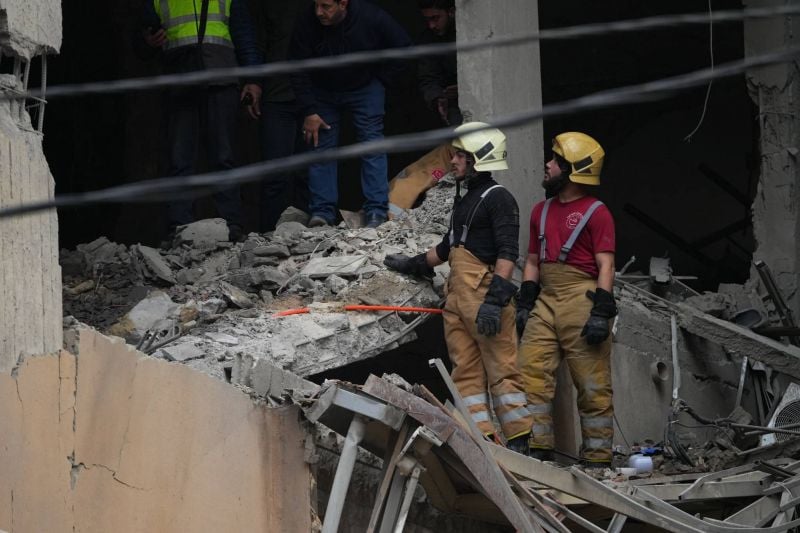
Dahiyeh, one day after the targeted assassination of al-Arouri. (Credit: Mohammad Yassine/ L'Orient Today)
BEIRUT — An Israeli strike in Beirut’s southern suburbs on Tuesday killed seven people, including Hamas’ number two Saleh al-Arouri, during a “targeted assassination.”
It remains unclear whether it was a drone or a fighter jet that sent the guided missiles that hit the building and the car.
A Lebanese security official told the Associated Press on Tuesday that “the attack appeared to have been carried out by a drone that fired missiles into the building, targeting one specific floor.”
On Wednesday though, a senior Lebanese security official told AFP that al-Arouri had been killed "not by a drone, but by guided missiles fired from an Israeli fighter plane." He mentioned the highly “precise” nature of the strike on the one hand, and the substantial weight of the missiles, which weighed around “100 kilograms” each.
Among the six missiles fired, four exploded, according to the official, including two destroying two floors before directly hitting the meeting room of Hamas officials. The Lebanese army found that the remnants of missiles matched those that Israel had fired into southern Lebanon, he added.
The strike also killed Samir Fendi and Azzam al-Aqraa, both leaders within al-Qassam Brigades. Ahmed Hammoud, Mahmoud Shahin, Mohammed Bsharat and Mohammed al-Reis, who have not yet been confirmed as affiliated with a particular group, have also been killed by the strike.
The attack, which has given Israel a significant accomplishment in its three-month-war against Hamas, reportedly happened during a meeting between Palestinian factions in the militant group’s office, located in the building that was struck.
Is it normal for Israeli jets and drones to infiltrate Lebanon’s airspace?
“Israel flies dozens of drones and jets all over Lebanon on a daily basis — this is not an isolated incident,” security and defense analyst Riad Kahwaji told L’Orient Today.
In 2022, The Guardian reported research that revealed how pervasive Israeli drones’ presence has been, with at least 22,000 overflights being documented in the past 15 years alone.
“Radars in Lebanon can see many of these drones” infiltrating its airspace, Kahwaji said. However, “neither the Lebanese Army nor Hezbollah have the ability nor air defense systems to counter these drones ... [which] can be small or big and carry bombs and missiles, ready to strike.”
“Using drones to get to the [southern] suburbs is very easy,” political analyst and retired Brigadier General Amin Hoteit, who is close to Hezbollah, told L’Orient Today. “The drone can fly over the sea, without anything detecting it, then it can cross the distance from the sea to the [southern] suburbs within several minutes, since the distance does not exceed four kilometers.”
In 2019, residents of a neighborhood south of Beirut threw rocks at a surveillance drone flying between the apartment buildings, bringing it down. Some time later, a second drone exploded near the same area.
The drone that exploded blew out the windows of a media office belonging to Hezbollah.
Was it an Intelligence failure of the Lebanese Army and Hezbollah?
The assassination “surely needed human intelligence to accurately determine the right timing and movement of the target,” Hoteit explained. “Air monitoring [a target] is not enough to determine the identity of a person, no matter how accurate and advanced the process is."
“There is no doubt that the attack required some sort of cyber espionage,” Hoteit said, adding that a wanted person needs to be entirely absent from the electronic world so that they are not being tracked
It remains unclear whether this was the case with Arouri.
Kahwaji posited that “Israeli spies and agents were able to penetrate and provide the Israelis with the coordinates of the office and the timing of when Arouri was in there."
“It is not an intelligence failure on the Lebanese Army’s part but [rather] on Hezbollah because the army was not tasked with providing security for this guy,” Kahwaji stated. “It is an intelligence failure inside the [southern] suburbs [of Beirut],” he said.
Beirut’s southern suburbs are a Hezbollah stronghold. However, thousands of civilians, who are not Hezbollah members or fighters, reside in these quarters, and are often — along with residents of southern Lebanon — caught in the crossfire between Hezbollah and Israel.
Can the Lebanese Army or Hezbollah protect the country against drones and fighter jets?
“The Lebanese Army stands handicapped in the face of these drones,” Kahwaji says.
Lebanon’s army has for a long time grappled with resource limitations, including outdated equipment, insufficient funding and even food shortages, hindering its ability to modernize and keep pace with evolving security threats.
“Western weaponry markets are closed in Lebanon’s face — to protect the Israeli and American interests, and, even if they were open, the country lacks the funds to buy advanced weaponry including an air defense system,” Hoteit explained. “Third, military aid from foreign countries does not include an air defense system.”
Iran and Moscow have previously offered Lebanon an air defense system but, under American pressure, the Lebanese state rejected it, Hoteit added.
Until now, Hezbollah has not confirmed nor denied owning an air defense system, he added.
Israel has always made it clear that possession of surface-to-air missiles is a no-no. Convoys suspected of transferring missiles of this type across Syrian territory have often been targeted by Israeli aircraft.
However, Hezbollah has been shooting down Israeli drones that regularly infiltrate Lebanon's airspace for years. Experts say this proves that they have some sort of defense system that jams or shoots down drones.
“From now on, we will confront the Israeli drones in the skies of Lebanon,” the party’s Security-General Hassan Nasrallah said in 2019, “The Israeli drones, when they enter Lebanese skies, we will work to bring them down.”
Will we ever know what really happened?
Israeli planes flying over Lebanese airspace “is a violation of the country’s sovereignty,” Kahwaji said, adding that there is however no shortage of incidents violating Lebanon’s sovereignty.
“Hamas being present, operating militarily in Lebanon and firing missiles out of Lebanon is also a violation of Lebanon’s sovereignty,” the analyst added. “Lebanon has become an arena for confrontation between the Palestinians and the Israelis.”
Asked whether anything was uncovered regarding the agents that fed intelligence information to the Israelis about Arouri, Hoteit said, “we don’t know much thus far.”
“A professional, extensive investigation to try to reach important results and information is ongoing,” he added.
According to Hoteit, it's now time for the Lebanese state, along with its security and intelligence apparatus, on one end, and Hezbollah, on the other end, to work to uncover how the Israelis were able to take down Hamas’ deputy political leader.
This article was amended on Dec. 5 to take into consideration the latest developments of the story. We notably added the hypothesis that it was a jet that carried the attack.

